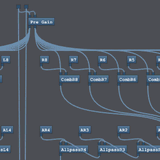
These are also commonly referred to as DAW's (digital audio workstations). In addition to the multitude of midi/audio options, these programs allow you to host plugins.
#Re wire plogue bidule pro#
The most popular examples of these would be Logic Pro, Sonor, Pro Tools, Digital Performer, Cubase. The original reason this thread was started was to draw some attention to the lesser known " host" programs which primarily serve as just that - an environment to host your VIs (virtual instruments). By using host programs, you can (in one location) load several instances of VDL2 for example, save your session, etc.

However - since Kontakt 2 came out and is capable outputting 64 channels, I think many people (myself included) have opted to run the VDL sounds within Kontakt. This isn't " hosting" because you're not launching the VDL2 plugin within Kontakt. All you're doing is loading the sounds in Kontakt.
#Re wire plogue bidule software#
Since VDL was written in Kontakt format, you can do this.Plogue has released version v0.9705 of Bidule, a modular audio software for Windows and Mac. Plogue bidule sample layout mac software#

#Re wire plogue bidule mac os#
Plogue bidule sample layout mac mac os x#.Plogue bidule sample layout mac for mac#.And then as soon as I hit a major roadblock, I render the stems and import into another program to jump the roadblock and add more ideas.Īnyways, I hope this helps. I'll typically start in one program and work up some ideas. It's also nice to change programs from time to time to break up the monotony and I get different ideas from different programs.


But I'll probably use that and export the stems into Energy XT or MultitrackStudio. The only feature it has that I need is the pitch envelope. I also use Energy XT because it handles some of my VST instruments a bit better and some of the early simple mixing is easier. For example, I'll use the step sequencer in FL Studio and render the multitrack stems and import them into MultitrackStudio Pro Plus where I'll overdub some more stuff and also arrange and edit and do nice automation and mixing. Most of the time I choose a BPM to work with early on, and then render the audio from each DAW and export into the other DAW's and overdub and mix and edit in the other DAW's. I use all of them from time to time because each one is better at some stuff than the others. And Music Creator 4 (which I don't use but it's a backup)


 0 kommentar(er)
0 kommentar(er)
